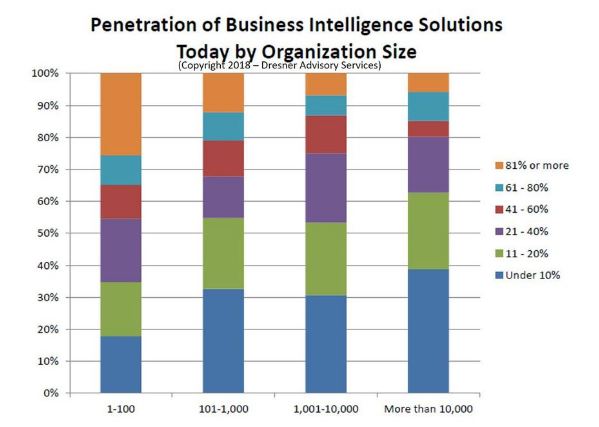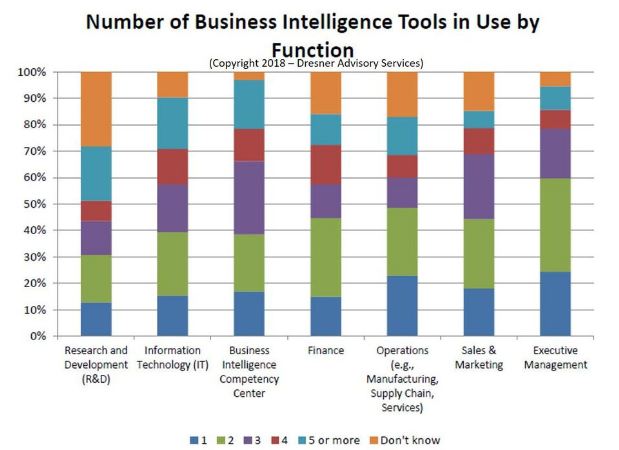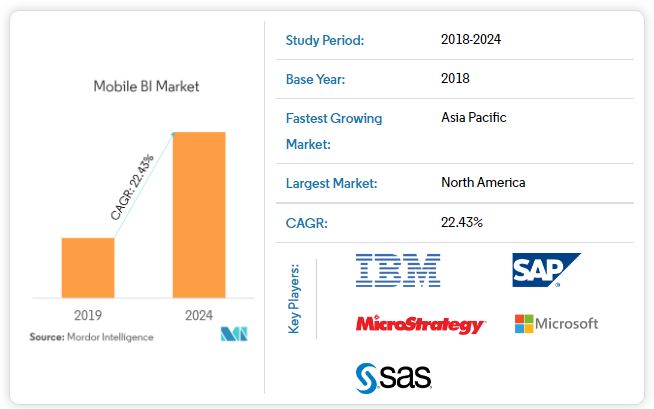Investopedia defines business intelligence (BI) as a set of processes and technical infrastructure that gather and analyze a company’s raw data into actionable insights. Some of the processes that fall under the umbrella term BI are data mining, descriptive analytics, performance benchmarking, and process analysis.
In recent years, the
business intelligence software industry has experienced rapid growth. According to Statista, the worldwide BI and analytics software market revenue will grow to US$22.8 billion by 2020. Following is an illustration of this:
Gartner predicts the worldwide revenue of BI tools to grow over
$22 billion by 2020. Gartner isn’t the only one predicting a bright future for the BI software industry; Reuters also predicts steady growth of BI tools in the next few years, with global revenues expected to reach
$29.48 billion by 2022.
So, it’s clear that the BI industry is growing at a rapid pace, and there are no signs of this growth slowing down in the coming years. At this point, you may want to know what’s enabling the rapid growth of BI tools and industry? It is the need to drive more business value from an organization’s data.
The Need for Intelligent Data Management Is Enabling the Rapid Growth of the BI Industry
Since it is the most valuable asset of any organization, data needs to be utilized fully. With intelligent data management solutions that extend across its public or private cloud data footprint, an organization can drive more business value from its data while making compliance easier for itself.
For several valid reasons, a company’s organizational and functional boundaries are limited in the use of their data siloes, making it tough to stay on top of an integrated data management system. This is the reason more and more organizations today are implementing intelligent data management systems to make it easier for themselves to manage their data.
With BI software or intelligent data management systems, organizations can identify inactivity across a customer’s storage and move less frequently accessed data to cost-efficient operations in a transparent manner. Furthermore, they can achieve this objective without having to make any changes to user or application access, which allows them to manage their data intelligently. What is the benefit of this? It reduces cold data storage costs by 50% while enabling an organization to retrieve key NAS space and regain performance.
In short, BI software enables truly intelligent data management. It does this by enabling the following five stages of intelligent data management:
1. Backup
Intelligent data management requires backing up all the workloads and making sure they can be removed after theft, loss, or outage.
2. Aggregation
A key function of intelligent data management is driving digital services and enabling an aggregated view of service-level compliance to safeguard data and ensures its availability across multiple cloud environments.
3. Visibility
Intelligent data management requires using unified and transparent controls for operations and handling performance issues to improve data management across multiple cloud environments.
4. Orchestration
To ensure the continuity of business as well as compliance, security, and the best utilization of resources for operations, data must be moved seamlessly to the optimal location across multiple cloud environments.
5. Automation
Intelligent data management requires automating data management. Data must learn to back itself, secure itself during routine activity, relocate to optimal location based on the needs of the business, and recuperate immediately.
With the steps involved in enabling intelligent data management understood, the next question would naturally be ‘why enabling intelligent data management is important?’ It is important because an intelligent system helps to move from manual methods towards intelligent, automated ones. The system evolves from policy-based to behavior-based by providing the needed intelligence, backup, aggregation, visibility, orchestration, and automation.
By doing the above, BI software for intelligent data management makes it possible to manage the massive amounts of continuously flowing data across highly distributed, multiple cloud infrastructures. The software can then be self-learning, automated in a secure manner, and orchestrated in an optimal way.
Organizations that implement BI software for intelligent data management are able to respond faster to their needs, improve efficiencies significantly, and increased their ability to deliver experiences and services that improve how people work and live. Moreover, value-based data governance allows them to enable and secure the future of their business.
For all production-based organizations, supply chain management is probably the most critical function; this is because the supply chain includes all the people, resources, technology, and activities included in creating and ultimately selling a product.
Many organizations today continue to use outdated supply chain models; they do not realize that the demands of the market are constantly changing, and newer models of management are needed to meet them.
The longer these organizations continue to use the traditional tools and processes of supply chain management, the greater their risk will be of being left behind by their competition. For these organizations, the sensible option would be to transition to intelligent solutions for supply chain management as quickly as possible.
Why is transitioning to intelligent supply chain management solutions important for organizations? Because doing so can help lower the organization’s costs, improve its profitability, and enable a competitive advantage.
Now, the next question would be “what’s included in intelligent supply chain management?” Every technology and tool that enables automated supply chain management. Some popular tools/technologies for enabling intelligent supply chain management include the Internet of Things (IoT) and mobile business intelligence. Let’s understand how IoT and mobile BI are helping to transform supply chain management.
How IoT is Transforming Supply Chain Management
The Internet of Things, abbreviated as IoT, is a key enabler of the technological transformation currently taking place in supply chain management. What is the exact role being played by IoT in transforming supply chain management?
The number of connected devices globally will reach
2.4 billion, according to Gartner. This ubiquity of devices presents the supply chain industry with a real opportunity to grow. With more connected devices, supply chains everywhere will be better positioned to increase their level of efficiency.
Some forward-thinking organizations are already deploying sensors. The idea is to make every supply chain touchpoint a data point that can not only be captured but can also be analyzed and refined for greater efficiency.
Sensors for monitoring the condition of shipped products and cloud solutions for optimizing the routes of delivery are some of the IoT technologies helping to transform supply chain management. Below are some of the ways IoT is helping transform the management of supply chains.
1. Fleet Management
Companies that operate an entire fleet of vehicles have wanted intelligent
fleet management solutions for years. This resource is highly sought-after because intelligent fleet management solutions capture data about the location and operations of the vehicle in real-time. This ability is made possible with the help of GPS and other technologies for tracking. Following are some of the application areas of these solutions:
* Fleets designed for last-mile delivery or long hauls; a goods-transportation semi-trailer truck for fulfilling an order is an example of this fleet
* Vehicles used for transporting employees to job sites
* Vehicles used to transport people from one location to another; this can include both private and public transportation
Perhaps the biggest advantage of using intelligent fleet management in these application areas is fulfilling customer orders faster, which helps to improve the end-user experience. Other benefits include lower driver headcounts, maintenance costs, and fuel consumption.
2. Inventory Management
With IoT, issues, and delays in inventory that force customers to shift to a business’s competitors can be eliminated. How does IoT accomplish this? By informing organizations when they need to reorder or restock products.
3. Asset Tracking
Real-time tracking of assets is enabled by connected sensors, making the job of supply chain managers much easier. Not only are they aware of a product, shipping container, or truck’s exact location, they also know the supply chain stage it is currently at.
Together with data analytics and cloud computing, this granular-level information can instruct models that provide the required data to generate certain efficiencies; staffing levels of related work and the availability of reciprocal assets allow organizations to achieve these efficiencies.
4. Operational Efficiency
By providing real-time visibility to the supply chain, IoT enables managers to find any deficiencies instantly. This ability allows the immediate resolution of problems or, at times, their prevention. In other words, IoT allows organizations to detect and resolve inefficient processes that are not only losing them money but are also negatively impacting their bottom line.
Managers no longer need to rely on undependable data from different teams spread across disparate locations; instead, they can make decisions based on insights into the supply chain they receive in real-time.
Understanding the Impact of Mobile Business Intelligence on Inventory Management
Mobile business intelligence is a relatively new concept that’s helping transform inventory management, which is a key function of supply chain management. In addition to making warehouse and store inventories management more efficient, innovative mobile tech and apps in inventory management are helping to take the customer service function to new heights.
Items that customers don’t like or find issues with are either returned in-person or shipped back to where they came from. Contrary to popular belief, the business or retailer is not at a loss here as they can simply move the item to one of their loyal customers. However, there’s a slight issue; the inventory can hurt the bottom line if exchanged or returned items cannot be viewed in real-time. The only way out of this is by implementing innovative technology, such as mobile BI, in inventory management.
Manual ways of tracking inventory, such as handwritten records or spreadsheets, are used by
almost 50% of small businesses today. Not only are these inventory tracking methods slow, but they are also ineffective.
Viewing transactions in real-time with these methods is a far-shot; they don’t even have accurate processes. So, what’s the solution? Implementing the mobile applications and technology designed to make inventory recording and management easier. If you don’t have an in-house team that can develop these apps for you, then you can hire a mobile app development company for this purpose.
Easy to manage, inventory management apps built by top app development companies are a worthwhile investment. To further convince you to invest in mobile application development for inventory management, the following are some ways inventory management is made easier by mobile applications and technology.
1. Make It Easier to Adapt to New and Changing Requirements
Adapting to new and changing requirements in inventory management is easier with mobile applications. You can factor new clients, new product types, changes in the storage location of manufactured goods, and more with mobile apps for inventory management.
2. Transform Inventory Management
Inventory apps, especially mobile BI apps, are helping to transform management. How are these mobile applications transforming how businesses manage inventory? By automating their workflow.
Inventory apps can be used to gather data automatically. Managers can use these apps to automatically and instantly collect data about the inventory at hand, its storage location, how it compares to demand, and other relevant information related to it.
Another advantage of these mobile applications is that they eliminate nearly all errors in counting. This feature makes it possible to retrieve lost items. It also allows noting down damaged equipment or goods that need to be revisited and dealt with promptly. Last but not least, data collected in one location can be transferred to a data storage facility in another location almost immediately. Coordination between geographically dispersed teams becomes easier and smoother due to these apps.
We have established that using IoT and mobile BI apps for inventory management has many advantages. Therefore, an increase in the use of these intelligent technologies for the performance of daily duties is to be expected from managers looking after supply chain, inventory, and warehouse. This will serve both them and their organizations well.
The Business Intelligence (BI) Industry—Understanding Its Current State and Where It’s Headed
Today, almost every organization is making use of business intelligence (BI) in some way since it is empowering businesses to accomplish goals that were no more than a pipe dream only a few years ago.
Not only does BI allow businesses to consolidate data from disparate sources into a single location, but it also allows them to extract valuable insights from this data. Business intelligence software also enables employees to quickly and efficiently access the relevant data to find answers to critical business questions.
Another advantage of BI software is that it allows organizations to benchmark their data against competitors. Perhaps the greatest benefit of a business intelligence system is that it helps to increase overall productivity by forcing or encouraging organizations and their employees to focus on only what’s important.
Recently, Dresner Advisory published a yearly market study report on the state of cloud computing and business intelligence. One of the findings of this report was that the importance of BI varied by industry. Following is an illustration of what Dresner found:
From the above graph, we find that the greatest demand for business intelligence (BI) solutions is in the advertising industry. The education industry comes in second place, followed by Retail and Wholesale, Technology, Healthcare, and Financial Services. Financial Services coming in the last place will be a surprise for some. However, the Financial Services sector is well-known for taking its time before completely embracing any new technology or concept.
Another interesting piece of research on the Business Intelligence (BI) industry is provided by the International Data Corporation (IDC). The market intelligence provider reveals in its 2019 study on the BI market share the business intelligence revenue by industry. Following is a pie-chart that shows the BI revenue share by industry:
From the above pie chart illustrating business intelligence revenues, we find that the banking industry has a 13.9% share, discrete manufacturing has an 11.3% share, professional services and process manufacturing are next with 8.2% share each, and the list is completed by the federal/central government with 6.8% share. However, more than 50% of the overall business intelligence revenue is shared by industries/sectors other than those listed above and mentioned in the report by IDC.
According to Statista, the Business Intelligence (BI) market is currently valued at
$20 billion. Another important piece of information related to the BI industry is how it has progressed in important over the years.
As found by Dresner Advisory and cited by SelectHub, the importance of business intelligence has progressively increased in some years and decreased in others from 2012 to 2019. Following is an illustration of this:
From the above graph, we find that the importance of BI was higher in 2012 than in 2013. It increased again in 2014 and decreased in 2015 and 2016 before increasing in 2017. However, the most significant increase in the importance of BI was in 2018.
However, this increase in the importance of BI was short-lived as the popularity of BI solutions took a downturn in 2019. Currently, just over 60% of the organizations see BI as ‘important,’ about 40% consider it ‘very important,’ and only 10% find it ‘critical.’ This means that a lot of groundwork still needs to be done by both the software and app developers of business intelligence solutions to win the confidence of organizations everywhere.
In 2018, Dresner Advisory Services conducted the Crowds Business Intelligence Market study. Following are some of the most important findings of the research:
From the above infographic, we find that executive management is the function that’s driving business intelligence the most. This is followed by operations, sales, finance, and marketing, respectively. Information technology (IT) is sixth on the list. The strategic planning function, the competency center, research and development (R&D), human resources, and manufacturing close out this ranking. This shows that human resources and manufacturing are the two functions in an organization with the least impact on the implementation and adoption/use of business intelligence (BI) solutions.
Another key finding of the Dresner Advisory Services study is that the number one reason organizations use BI solutions is to improve decision making. Following is an infographic showing the importance of the different business intelligence (BI) objectives for organizations:
From the above infographic, we learn that the most important business intelligence objective for organizations is improving the decision-making process. This is considered critical by more than 50% of the surveyed organization.
Cost savings and improved operational efficiency are found to be the next most important BI objectives since more than 35% of the organizations consider critical. Growth in revenues is next with just over 30% of the organizations considering it to be critical. Increased competitive advantage is another key BI objective for organizations. The BI objectives that got the least votes from organizations in terms of importance were enhancing customer service and compliance/risk management.
In addition to the above, Dresner Advisory also found the five initiatives and technologies that were the most critical to business intelligence (BI) included dashboards, data warehousing, reporting, advanced visualization, and end-user self-service. Following is an illustration of this:
.jpg)
From the above infographic, we find that dashboards are strategically more important to business intelligence (BI). Reporting is another major BI initiative. End-user ‘self-service’ is third on the list, and its inclusion catches the eye. This is basically a portal where an organization’s documentation, data, and automated capabilities are pulled together to
cater to end-users of their IT services specifically. The top five closes with advanced visualization and data warehousing. Data warehousing is a well-known concept, while advanced visualization refers to an advanced technique that leverages autonomous or semi-autonomous data analysis to gain
valuable insights, generate recommendations, and make predictions.
Dresner Advisory also found that organizations with an employee count of less than a hundred people had the highest adoption or penetration rate of BI in 2018. It was seen that smaller businesses were more likely to use BI and analytics apps on a daily basis as compared to mid-size companies and big enterprises. Considering this finding, app developers or app development companies should probably be targeting smaller businesses for their BI apps. Following is an illustration of what Dresner found:
From the above graph, we find that companies with 100 or fewer employees had the highest rate of BI penetration or adoption during the previous year. This penetration or adoption rate decreases with the increased employee count, as companies with over ten thousand employees have the lowest rate of BI penetration or adoption.
The last bit of information from Dresner’s research that we want to highlight here is the number of business intelligence (BI) tools in use by function. According to Dresner, the function that is most familiar with the number and types of BI tools being used in an organization is executive management. Following is an illustration of this:
In 2018, business intelligence (BI) experienced growth in many different aspects and application areas. 2019 has been no different, as BI has seen exponential growth during the year. So, what is enabling this rapid growth of BI? The three main trends shaping BI growth are discussed next.
The 3 Main Trends Shaping BI Growth
In 2019, the focus of most organizations is on growth in all aspects of their business. Since we’re living in an increasingly connected world, the success of these organizations in achieving their growth objectives will depend heavily on their adoption and use of the right technology.
Today, an enormous amount of data is available to organizations, and filtering through it to get valuable or required insights is a real challenge. However, disruptive technologies such as AI and the cloud are making it easier for organizations to gather data and then analyze it to gain critical insights. This is the reason that they make up the top three trends shaping BI growth today. Following is a brief look at these trends:
1. Improved AI
In the past few years,
artificial intelligence (AI) has become increasingly critical for organizations everywhere. The reason for this is that AI makes it easier and faster for them to process information and complete tasks in an accurate and cost-effective manner. For example, an AI-enabled inventory management system can help to lower inventory losses while improving processing times. Additionally, chatbots can respond to a customer query much quicker than any human.
Due to all the benefits it offers, AI is predicted by PWC to contribute more than $15 trillion to the global economy by 2030. In 2020, we can expect organizations to increase their investment towards finding new ways of leveraging AI technology to improve operations and increase applications of machine learning.
2. BI’s Transition to the Cloud
With organizations accessing and sharing data rapidly, the complete transition of BI to the cloud is only a matter of time. For organizations, there has not been a better time to move to the cloud than now—more computing power is available at lower costs, and access to data has become easier, making this transition a viable option. In 2020, we predict that organizations will increasingly use hybrid and multi-cloud solutions to leverage BI better and get the best results.
3. Security and Access Control
With organizational data being generated faster than ever, securing this ‘intelligence’ and the process involved in collecting and analyzing the data is now critical for businesses. Securing business intelligence and the process of sourcing it is most important for businesses in highly regulated industries with strict compliance requirements.
Organizations need to focus increasingly on improving data governance, and this is what will happen in 2020 and beyond. There will be a greater emphasis in organizations on reducing risks related to the gathering and analysis of business intelligence in order to win the confidence of the decision-makers and key stakeholders. IT teams will work closely with these people to build processes that ensure trustworthy databases and analytics going forward.
These are some of the major trends that will shape the growth of the business intelligence (BI) industry in 2020 and beyond. However, there is another trend in BI that has been catching a lot of eyeballs recently; that trend is mobile business intelligence or mobile BI. In the next section, we will discuss the mobile BI market and its growth.
The Mobile Business Intelligence (BI) Market Industry is Growing
Whether they specialize in Android app development or iPhone app development, all
app development companies need to focus increasingly on developing mobile BI apps. This is because the mobile BI industry is growing rapidly.
According to Mordor Intelligence, the mobile BI market will grow at a CAGR of 22.43% during the forecast period 2019-2024 to grow to over
US$20 billion by the end of the forecast period. Following is an illustration of this:
For people not familiar with the concept, mobile BI refers to the use of business data and dashboards on smartphones and tablets. With more and more businesses wanting to access their data and dashboards on mobile devices, it would be sensible of
top app development companies to increasingly create mobile apps that allow employees of an organization to access business intelligence using their smartphone or tablet.
Currently, there are two ways of gaining access to business intelligence (BI) applications through mobile devices:
* Accessing them on the web via a mobile browser
* Accessing them through an app designed for a specific platform such as Android or iOS. The mobile OS for the app will be determined by what the particular business needs.
Of the two approaches to access BI apps mentioned above, the best approach would depend on the requirements and needs of a particular business. We say this because there are advantages and disadvantages to both accessing BI apps via a mobile browser and accessing them through a mobile application.
However, one thing that cannot be argued is that mobile BI is one of the fastest-growing trends in the software industry. Why is the popularity of mobile BI increasing rapidly? Because it makes a promise that executives and users of BI apps just cannot ignore. What is the promise that BI makes? Access to business-critical information on-demand and in real-time. Not many other current technologies can match this.
The Benefits of BI Mobile App Development for Businesses
AI has already given a huge boost to business intelligence (BI), and the advent of mobile apps for BI will help businesses gain a significant competitive advantage.
With the above in mind, many businesses today are turning to app developers, such as mobile app development companies, to develop great BI apps that enable the following benefits for them:
1. Greater Insights into Customer Behavior
Today, businesses get access to several channels for communicating with customers when they adopt an omnichannel strategy. These channels include (but are not limited to) direct calls, instant messengers, website, email, social chats, and web applications.
With these multiple touchpoints, organizations are able to generate huge amounts of critical business data that provide valuable insights into customer behavior and preferences; this knowledge is leveraged by mobile BI applications to create a customer profile and allows businesses to make the right decisions.
2. More Insights into Revenue Driving Strategies
In order to improve the return on investment (ROI), businesses should build complete user personas and source critical information, such as what encourages leads to convert. This can be achieved with the right business intelligence (BI) applications that are tailored to the needs of a business.
3. More Awareness About the Business Competition
Most businesses will struggle to gain a competitive advantage if they continue to use traditional techniques while competing in current markets. Relying on Google analytics, analytics software, and financial information is no longer sufficient.
Businesses should also be looking at the latest market trends, social signal, and secondary sources of data; all of this can be accomplished with the development and use of the right BI mobile application. You will have all the information you need at your fingertips.
4. Increased Knowledge of Business Problems
Key performance indicators (KPIs) for the business, balance sheet, and profit and loss (P&L) statements are overly exploited by business executives at many organizations today. Even when the executives thoroughly vet these business documents, they are unable to find the bottlenecks and trends that have the biggest impact on the business’ health. With mobile BI apps that are integrated with the different systems in place at the organization, business executives can find everything that is not revealed by the documentation and traditional systems mentioned above.
We will conclude by saying that mobile BI apps offer many advantages that organizations today can leverage to benefit the company’s bottom line. Perhaps, this is the reason we are witnessing more and more organizations today using the top app development companies to build mobile applications that provide them with the needed business intelligence.
Conclusion
From the above statistics and information, we can say that both the business intelligence (BI) industry and mobile BI industry are headed in the right direction. Innovation in BI and mobile applications that enable greater access to and use of business intelligence are likely to push the adoption of business intelligence and mobile BI apps higher.
Some of the trends shaping the growth of BI are improved artificial intelligence (AI), BI’s transition to the cloud, and greater security and access control of the business systems enabling data collection and analysis.
Overall, things look bright for the business intelligence (BI) and mobile BI industries in 2020 and beyond, especially in terms of user adoption and growth. In fact, there has never been a better time for businesses to hire a
mobile app development company to build great BI software and applications.
Our Review Process
Our writers spent more than 10 hours researching the adoption and growth rate in both the business intelligence (BI) industry and the mobile BI industry. To come up with the information and statistics presented above, they read through the research of top sites such as Forbes, SelectHub, Statista, Mordor Intelligence, and more. This research process makes the information provided by us as trustworthy.

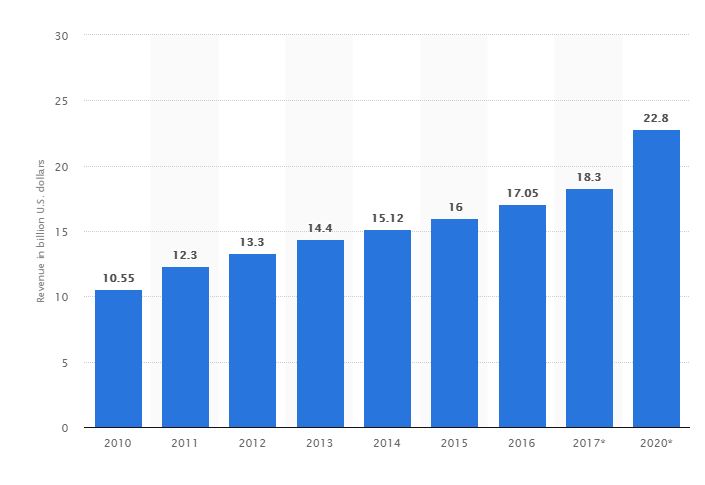
.jpg)
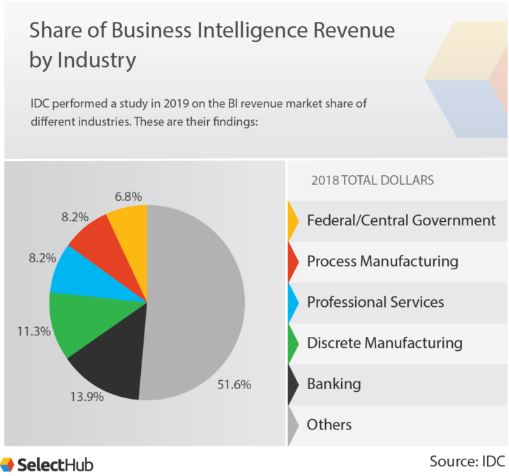
.jpg)
.jpg)
.jpg)
.jpg)
